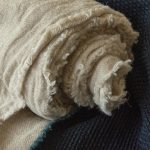Silks, Synthetics And Society: How One Artist Turns Fabrics Into Political Statements
Berlin-based artist Gulnur Mukazhanova received a peculiar inheritance from her grandmother: a collection of traditional Kazakh garments and textiles. She wore one of the garments for her wedding, to question the dominance of the customary white dress, while the rest have inspired her recent works.
Sadly, traditional crafts have been steadily disappearing in Kazakhstan, Gulnur’s homeland. A recent fashion for (pseudo)traditional rituals brought about a proliferation of low-quality merchandise including dresses, fabrics, and their ornamentation.
Her most popular pieces take inspiration from traditional Kazakh wall-hangings called tuskiiz, which were often hung above the bed. Their rectangular shape is a symbol of a doorway between worlds, while the circular forms within link back to pre-Islamic Turkic cultures that worshiped the sun. Gulnur’s works use similar shapes with a streamlined colour palette to put fabrics and their combinations centre stage.
She stretches felt across wooden frames to liken it to paintings, creating physical and metaphorical tension. This highlights the fact that wool can be soft and fragile yet transforms into something very different depending on the technique used. She combines it with silk threads to juxtapose the textures further – especially powerful in her single colour works, where the opposition of silk and wool create enchanting effects.
Some of her felt works, which to western eyes might be reminiscent of Jackson Pollock paintings, are in fact political statements. In her Post Nomadic Reality series, colours intentionally flow out of their expected boundaries. She says: “Misshapen and blurred, they serve as metaphors for a society exploding – refusing to continue being pushed into a set framework.”
For Traditional Values during Globalisation, she glues together handmade felted masks, creating an amalgamation of facelessness. It’s a commentary on the loss of traditional values in her home country and in global society – a society in which improved connectivity and perpetual visibility only increases alienation and uniformity.
Gulnur also works with synthetic materials, for very special reasons. In False Hope or Moment of the Present, layer upon layer of shiny fabrics are suspended in mid-air. The work highlights the falseness of modern society – from political promises to personal presentation on social media. Gulnur is particularly concerned with the social situation in Kazakhstan, where hopes of change are regularly crushed. The fabric she uses is a fake version of what was once a precious commodity – silk –referencing Central Asian history and her homeland, which formed part of the Silk Road.
In a recent work, Line of the Horizon, Gulnur explores the value of human life and its fragility. This time synthetic fabrics are combined with real silks and exhibited as a long narrow line stretching endlessly around a gallery space with no end in sight – held together by mere pins. It’s a reference to all the loss of life in the last few years, whether from Covid or deliberate acts of violence by governments and countries.
Fortunately, we have much more to look forward to from this artist. Gulnur is considering how to simultaneously draw attention to historic artefacts, contemporary uses of fabric, and to today’s most pressing social and political issues. She has recently received a delivery of Uzbek ikat fabrics, both traditional and modern, delicate and brash. What will she do next, I wonder?






















































4 Comments
Wendy Avery
Lovely, I am wondering how she felts such large works of art. It looks as though she is nuno felting, originally a Japanese technique.
Alinda Drury
Beautiful work and sentiments. Such a creative tribute (and lament) to traditional fabric uses. I highly recommend the book “Worn: A People’s History of Clothing” by Sofi Thanhauser for a comprehensive look at the development of fabric industries and their effects on cultures/societies.
Cynthia Lachance
Thanks for the book recommendation. I’ve just placed a hold for it from my library.
Cynthia Quintanilla
I’m 73 and lament how much the traditional indigenous fabrics and techniques of Mexican artisans are almost gone. I remember as a 17 year old scholarship student in Mexico City seeing exquisite handmade textiles in markets that were colorfully embroidered. They were from various regions of the country. How I wanted to buy them and dress like Frieda Kahlo. Unfortunately, being a student of meager means all I could do was admire the art I saw. Fast forward 40 years later, I could afford the textiles, but the quality and original beauty had disappeared. The embroidery was clumsy, awkward and the fabrics cheap. Those that resembled the ones of long ago were exorbitantly expensive and were pieced items. Exquisite embroidery pieced to mid-range fabrics made to look authentic and totally handmade. A travesty by any standard. I suppose the nostalgia of my youth was brought to mind reading the article today. Many textiles techniques and fabrics have been lost and only those who remember them can bring attention to reviving interest in at least some of them. Imagine teaching youngsters to knit or embroider !